 = 0.714 and 0.833) at short distances from the atomiser nozzle. All NO2 thus formed disappeared shortly afterwards. Negative values obtained at longer distances are attributed to instrumental errors.
= 0.714 and 0.833) at short distances from the atomiser nozzle. All NO2 thus formed disappeared shortly afterwards. Negative values obtained at longer distances are attributed to instrumental errors.
Emissions of NO2 were calculated by subtracting the values of NO concentration from those of total-NOX.
At 900 °C furnace wall temperature the emission of NO2 is significant only at stoichiometric and fuel-rich conditions, especially the latter (see Figures 46 and 47). Very small amounts of NO2 are formed in fuel-lean conditions ( = 0.714 and 0.833) at short distances from the atomiser nozzle. All NO2 thus formed disappeared shortly afterwards. Negative values obtained at longer distances are attributed to instrumental errors.
= 0.714 and 0.833) at short distances from the atomiser nozzle. All NO2 thus formed disappeared shortly afterwards. Negative values obtained at longer distances are attributed to instrumental errors.
Relatively large amounts of NO2 are also formed at short distances at stoichiometric conditions (125 ppm-wet from fuel M1 and 108 ppm-wet from fuel G1 are formed at 250 mm). However, they tend to disappear as combustion progresses at longer distances, although 50 ppm-wet NO2 are emitted by fuel G1.
Emission of NO2 is important under fuel-rich conditions only ( = 1.200). 277 ppm-wet of NO2 were emitted from fuel M1, whereas 144 ppm-wet were emitted from fuel G1.
= 1.200). 277 ppm-wet of NO2 were emitted from fuel M1, whereas 144 ppm-wet were emitted from fuel G1.
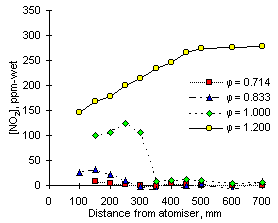
| 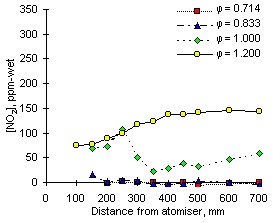
|
| Figure 46: NO2 concentrations from fuel M1 at 900 °C | Figure 47: NO2 concentrations from fuel G1 at 900 °C |
In both cases the formation of NO2 is very fast in the first 100 mm after the atomiser nozzle, increasing almost linearly afterwards until a maximum value is reached at about 500 mm from the atomiser nozzle. The concentrations of NO2 stabilise subsequently at the values of emissions quoted above.
The emissions of NO2 obtained at 900 and 1,100 °C show a low dependence on the furnace wall temperature.
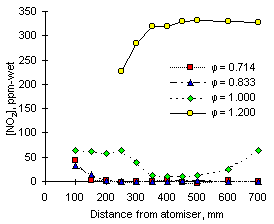
| 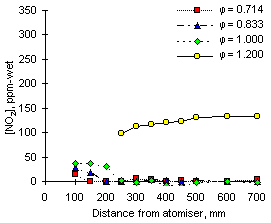
|
| Figure 48: NO2 concentrations from fuel M1 at 1,100 °C | Figure 49: NO2 concentrations from fuel G1 at 1,100 °C |
Significant amounts of NO2 are formed from both fuels at 1,100 °C near the atomiser at low equivalence ratios. The values measured from fuel M1 at 100 mm from the atomiser nozzle reach 44 ppm-wet in fuel-lean conditions ( = 0.714), whereas 15 ppm-wet are measured from fuel G1 at similar conditions.
= 0.714), whereas 15 ppm-wet are measured from fuel G1 at similar conditions.
As the combusting mixture becomes less fuel-lean ( = 0.833 and 1.000) larger amounts of NO2 are measured from both fuels at short distances. Also, the time taken by NO2 to disappear increases (see green diamonds in Figures 48 and 49).
= 0.833 and 1.000) larger amounts of NO2 are measured from both fuels at short distances. Also, the time taken by NO2 to disappear increases (see green diamonds in Figures 48 and 49).
Finally, formation and emission of NO2 in fuel-rich mixtures are high. NO2 is formed at 1,100 °C at a faster rate than at 900 °C furnace wall temperature. The maximum values of emissions are reached at approximately 350 mm from the atomiser nozzle, a much earlier stage than at 900 °C.
However, the effect of the furnace wall temperature (and, in turn, the flame temperature) on NO2 emissions at  = 1.200 cannot be clearly established. Whilst emissions of NO2 from fuel M1 suffer an increase of 50 ppm-wet from 900 to 1,100 °C, emissions from fuel G1 decreased by 12 ppm-wet. This can be observed in Figure 52, which shows a graph of fuel-N conversion to NO2 at exhaust.
= 1.200 cannot be clearly established. Whilst emissions of NO2 from fuel M1 suffer an increase of 50 ppm-wet from 900 to 1,100 °C, emissions from fuel G1 decreased by 12 ppm-wet. This can be observed in Figure 52, which shows a graph of fuel-N conversion to NO2 at exhaust.
Readings of NO2 could not be performed at  = 1.200 and 1,200 °C, as explained earlier.
= 1.200 and 1,200 °C, as explained earlier.
Measurements of NO2 obtained in other conditions are shown in Figures 50 and 51.
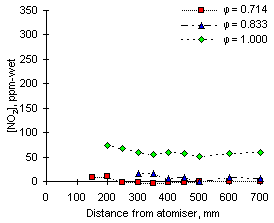
| 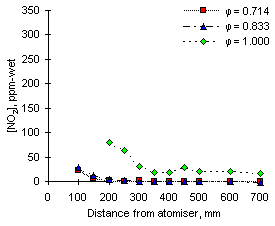
|
| Figure 50: NO2 concentrations from fuel M1 at 1,200 °C | Figure 51: NO2 concentrations from fuel G1 at 1,200 °C |
Emission of NO2 in fuel-lean conditions was negligible, as at lower furnace wall temperatures. Although measurements could not be made at very short distances from the atomiser nozzle, readings of NO2 at  = 1.000 were higher than at lower furnace wall temperatures. Figure 51 seems to indicate the existence of a peak of NO2 concentration at 200 mm from the atomiser nozzle or less. Approximately 58 ppm-wet were emitted finally by fuel M1, whereas fuel G1 emitted 20 ppm-wet. They represented conversions of 58 % and 47 % for fuels M1 and G1, respectively.
= 1.000 were higher than at lower furnace wall temperatures. Figure 51 seems to indicate the existence of a peak of NO2 concentration at 200 mm from the atomiser nozzle or less. Approximately 58 ppm-wet were emitted finally by fuel M1, whereas fuel G1 emitted 20 ppm-wet. They represented conversions of 58 % and 47 % for fuels M1 and G1, respectively.
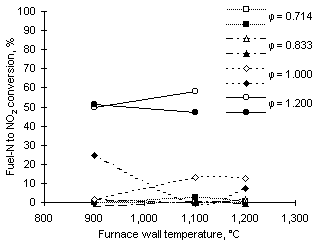
Figure 52 shows a graph of fuel-N conversion to NO2 at exhaust. Maximum conversions are reached at fuel-rich conditions, ranging from 50 to 60 %. Lower equivalence ratios yielded lower conversions, whilst in fuel-lean conditions it was negligible at all furnace wall temperatures. Factors such as the furnace wall temperature or the nitrogen content of the fuel did not seem to influence the conversion of fuel-N into NO2.
 Previous |  Table of Contents |  Next |